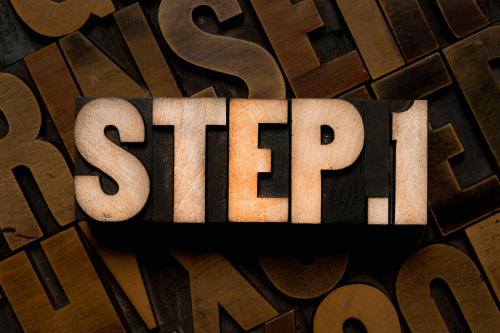

When embarking on the journey of Narcotics Anonymous (NA), participants are introduced to the 12-step program—a structured path toward recovery from substance use disorders. The first step serves as the foundation for the entire program, where individuals recognize the need for help and acknowledge their lack of control over addiction. Step 1 in NA reads:
“We admitted we were powerless over our addiction—that our lives had become unmanageable.”
This is a profound moment of surrender, signaling a shift from denial to acceptance. It helps people struggling with substance abuse recognize that change begins only after they acknowledge the limitations of their own willpower and their most sincere desire to stop using drugs.

At its core, Step 1 in NA requires an honest admission that addiction has taken control, leaving life in chaos. This step emphasizes personal responsibility while also teaching that reliance on sheer willpower alone is not enough. Members come to realize that they must admit complete defeat, acknowledging that they can no longer handle drugs or other mood-altering chemicals without falling deeper into destructive behaviors.
The admission, though difficult, is a necessary foundation. From here, participants can begin the healing process—learning to live without drugs and reconnecting with others in mutual support groups. For many, acknowledging that they are powerless over addiction is both daunting and liberating, marking the beginning of recovery from an otherwise overwhelming struggle.
Step 1 serves as a moment of truth. Admitting powerlessness over addiction is only half the truth; many people struggling with addiction spend years trying to control their behavior, only to find that the harder they fight, the more unmanageable their lives become. This pattern can leave them emotionally drained, leading to feelings of spiritual pain and complete defeat.
However, accepting this defeat is not about failure—it’s about laying down the burden of constant struggle. It represents a starting point for change. Admitting powerlessness opens the door to asking for help and acknowledging the need for a power greater than oneself. Whether that higher power is spiritual, community-based, or simply the NA fellowship, this realization plays a key role in rebuilding lives.
The 12-Step model has its roots in the early 20th century, when Bill Wilson and Dr. Bob Smith founded Alcoholics Anonymous (AA) in 1935. Both men, recovering alcoholics themselves, sought to create a structured program that could help others achieve sobriety and maintain long-term recovery. Their approach was grounded in their own experiences and emphasized spiritual growth, self-reflection, and mutual support.
Narcotics Anonymous (NA) adopted the 12-Step model in 1953, tailoring it to meet the specific needs of individuals struggling with narcotics addiction. This adaptation allowed NA to address the unique challenges faced by those addicted to drugs other than alcohol. Today, the 12-Step model is a cornerstone of numerous recovery organizations and mutual support groups worldwide, including both NA and AA. Its principles continue to guide countless individuals on their journey to recovery, offering a path to healing and a supportive community.

The phrase “our lives had become unmanageable” is central to Step 1. Addiction doesn’t just impact the physical body; it also wreaks havoc on relationships, finances, mental health, and emotional well-being. People caught in the grip of addiction may lose their jobs, alienate family members, or find themselves isolated from recovery houses or recovery communities that could offer support.
Those who try to stop using substances often experience withdrawal and cravings—an overpowering desire to use again despite their best intentions. The mental obsession with substance use leads to repeated relapse, reinforcing the feeling that recovery is impossible through personal effort alone. This cycle highlights the need to embrace powerlessness and the inability to manage one’s own lives to begin moving forward.
Dishonesty can be a significant barrier to recovery. When individuals struggling with addiction are not truthful with themselves or others, they create a sense of separation and isolation that can impede their progress. This dishonesty often leads to feelings of guilt, shame, and anxiety, which can trigger cravings and increase the risk of relapse.
In the context of the 12-Step program, dishonesty can prevent individuals from fully acknowledging their powerlessness over addiction and the unmanageability of their lives. This lack of honesty makes it difficult to surrender to the disease of addiction and seek the necessary help. Moreover, dishonesty can damage relationships with sponsors, therapists, and support group members, undermining the sense of community and mutual support that is crucial for recovery. Embracing honesty is essential for building trust, fostering connections, and creating a solid foundation for long-term recovery.
Step 1 also addresses both the mental aspect and spiritual part of addiction. The physical aspect refers specifically to the compulsive use of drugs and the inability to stop using once initiated, emphasizing that this aspect is a significant part of the overall struggle with addiction. Many participants describe feeling lost, as though life lacks meaning or direction. This emotional emptiness often drives substance abuse in the first place, as drugs become a temporary solution to deeper issues.
Through NA, participants learn that the spiritual awakening achieved in recovery brings freedom from this emptiness. Surrendering to powerlessness allows them to confront their exact nature and begin rebuilding their sense of self. This step also invites them to explore what spiritual disease means—understanding that addiction is more than a physical problem. Healing requires addressing the emotional and spiritual dimensions of recovery as well.
In Narcotics Anonymous, surrender is not about giving up but about realizing they have absolutely no choice but to accept help in order to recover. People often come to NA after exhausting every attempt to control their addiction, feeling trapped by outrageous sorts of behaviors and emotional turmoil. Surrender means letting go of these failed attempts and accepting the need for change through outside support.
This process doesn’t happen overnight. The first step may involve grief and even fear, but it also offers great freedom. By acknowledging that they cannot handle the problem alone, participants open themselves up to equal recovery through the NA fellowship. They learn to rely on the shared experience of NA members and begin their journey toward a drug-free lifestyle.
The first step of the 12-Step program can be daunting and humbling. Admitting powerlessness over addiction and recognizing the unmanageability of one’s life is a challenging yet crucial part of the recovery process. This step sets the stage for growth, development, and spiritual awakening.
To overcome resistance to the first step, individuals can focus on the goal of acknowledging powerlessness and surrendering to the disease of addiction. Seeking support from others, such as a sponsor or therapist, can provide guidance and encouragement. Practicing self-compassion and patience is also vital, as this process takes time and effort. It’s important to remember that there is no one right way to complete the first step; each person’s journey is unique, and it’s okay to work through it in their own way.
Like Alcoholics Anonymous, Narcotics Anonymous emphasizes community and mutual support groups. NA members come together to share their struggles and successes, creating a space of accountability and encouragement. These connections are essential, as recovery from addiction is rarely achieved in isolation.
Participants learn that families generally benefit from these support groups too. Addiction affects not just the person struggling, but also those closest to them—spouses, children, and friends. Family members often attend meetings alongside participants, finding their own healing within the recovery community.
Working the 12 Steps in NA involves a journey of spiritual growth, self-reflection, and mutual support. These steps are designed to help individuals overcome addiction and achieve long-term recovery. The process includes admitting powerlessness, seeking a higher power, making amends, and practicing spiritual principles in all aspects of life.
In NA, individuals work the 12 Steps with the support of a sponsor and a community of peers who are also in recovery. This collaborative approach involves sharing one’s story, working through the steps, and integrating the principles of recovery into daily life. NA meetings provide a safe and supportive environment for individuals to share their experiences, receive guidance, and connect with others facing similar challenges.
By working the 12 Steps in NA, individuals can gain a deeper understanding of their addiction, cultivate a sense of spirituality and purpose, and build a strong foundation for long-term recovery. The 12-Step program offers a roadmap for recovery, and NA provides a supportive community and a wealth of resources to help individuals achieve their goals.
While Step 1 may feel like the hardest part of recovery, it is only the beginning. Despite a sincere desire to overcome addiction, the subsequent steps build on this initial admission, guiding participants through a fearless moral inventory and other self-reflective practices. They will explore how their past actions led to addiction and develop tools to navigate life with accountability.
Through the 12-step process, individuals begin to experience spiritual awakening and personal growth. They come to terms with the exact nature of their struggles, learning how to repair relationships and rebuild trust through direct amends. These steps ultimately help participants completely change their outlook on life, allowing them to manage daily challenges without relying on drugs.
Step 1 in NA is more than just a statement of admitting we were powerless—it’s a courageous leap toward freedom. For many, it is the hardest step, requiring them to let go of their pride and face the reality of addiction. But in doing so, they open themselves to the support and wisdom of the NA community.
This step marks the end of denial and the beginning of real change. It offers a path from felt misery to hope, showing participants that even though their lives had become unmanageable, they can still reclaim their future. Through commitment to the recovery program, they find not only freedom from addiction but also the tools to lead successful days filled with purpose and connection.
Recovery is a journey, and Step 1 is the first step on a path toward healing and renewal. With the support of mutual support groups, participants learn that they are not alone, that change is possible, and that recovery—no matter how difficult—offers the promise of a better life.

At Sullivan Recovery, as an in-network provider we work with most insurance plans, such as:
And More
If you or a loved one are struggling with mental health challenges or substance abuse, reach out to Sullivan Recovery today. Our team of compassionate professionals is here to support your journey towards lasting well-being. Give us a call at 949-836-7180.
Step 1 in NA reads: “We admitted we were powerless over our addiction—that our lives had become unmanageable.” It is the first step in NA’s 12-step program, where individuals acknowledge that they cannot control their addiction through willpower alone. This admission serves as the foundation for recovery, helping participants accept the need for external support.
Step 1 is crucial because it shifts the individual’s mindset from denial to acceptance. Admitting powerlessness over addiction allows participants to stop fighting against their dependency and start embracing solutions. It also opens the door for them to engage fully with the NA community, where mutual support is key to maintaining long-term recovery.
Admitting powerlessness means recognizing that addiction is beyond personal control. This acknowledgment provides relief from the emotional and mental exhaustion of trying to manage the addiction alone. It empowers participants to focus on the recovery process, inviting spiritual, emotional, and mental healing through the support of others and through a power greater than themselves.
After completing Step 1, participants move on to the next steps, such as conducting a fearless moral inventory and making direct amends. These steps guide them in understanding the root causes of their addiction, repairing relationships, and building new coping strategies. Each step builds upon the foundation established in Step 1, helping participants gradually regain control over their lives and find fulfillment in a drug-free lifestyle.